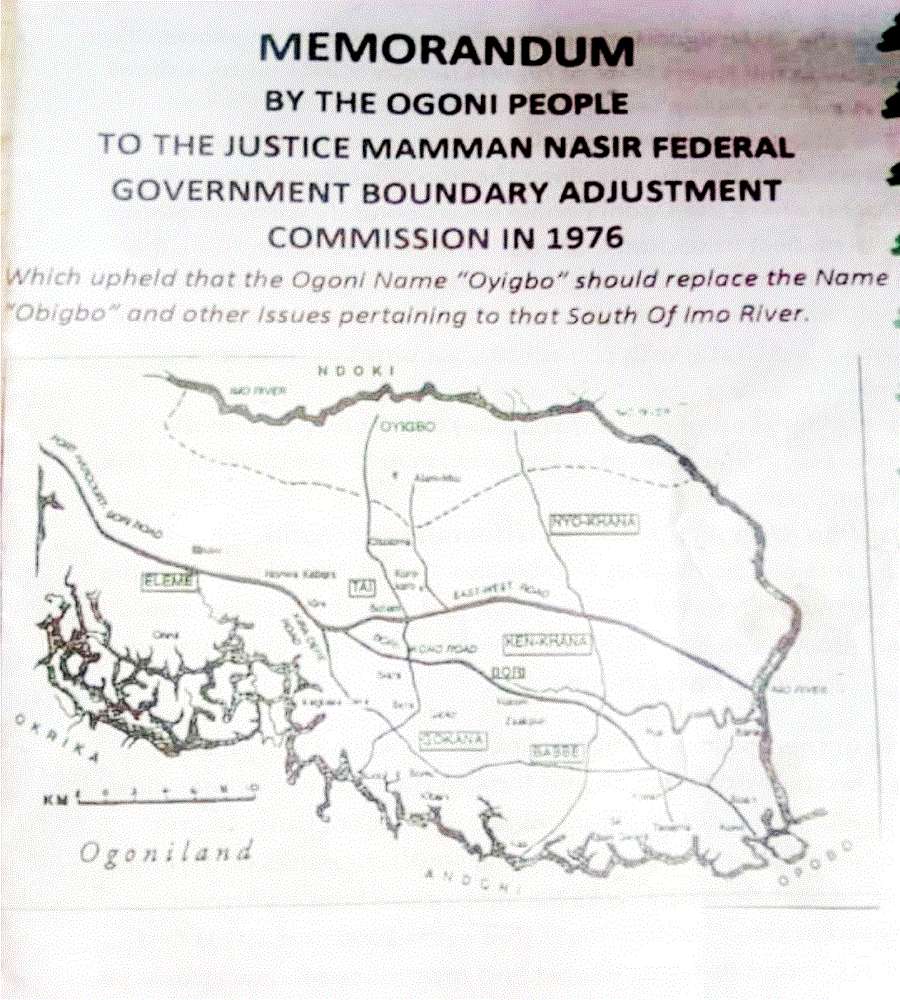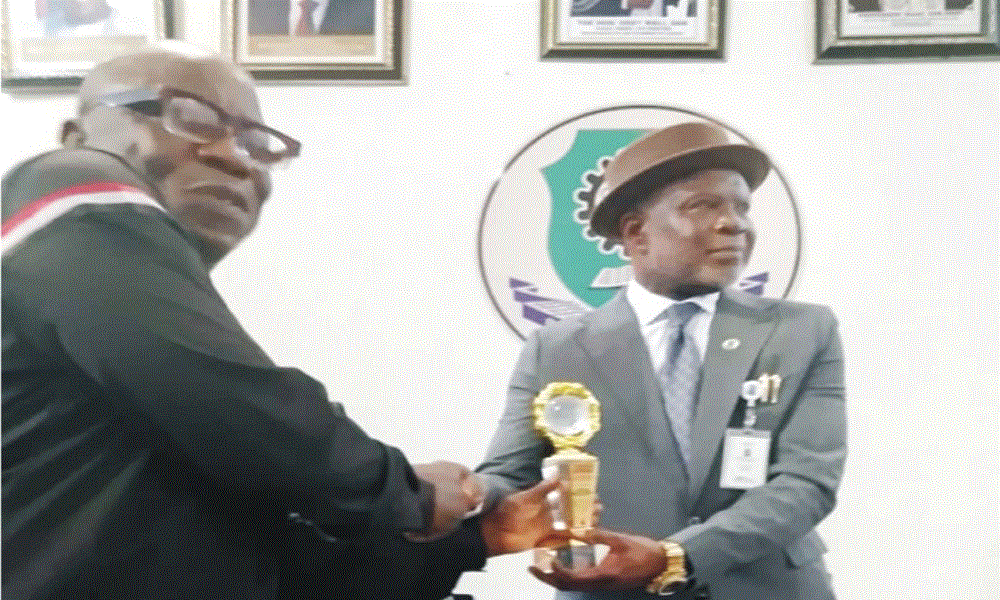Memorandum By The Ogoni People To Justice Mamman Nasir Federal Government Boundary Adjustment Commission In 1976

(Which upheld that the Ogoni name “Oyigbo” should replace “Obigbo” and other issues pertaining to that area of South of IMO River)
We the undersigned on behalf of ourselves and the people of Ogoni in the Rivers State of Nigeria hereby most humbly submit this memorandum on:
The adjustment of the boundary between the imo State and the Rivers State, particularly along the Imo River from Obigbo to Opobo where the Ogoni people have boundary with imo State, with respect to section C of your terms of reference.
The adjustment of the boundary between Ogoni in the Rivers State of Nigeria and Andoni and Nkoro in Opobo Division of the Cross River State, with respect to your terms of reference (a) and
The integration of the Wafe (Wisue) community now in the Cross River State with their kith and kin in Khana Division of the Rivers State.
The Imo River as the Northern boundary of Ogoni
The reasons behind our humble but strong submission that the State in which the Ogoni people are situate should have the Imo River as its boundary with the Imo State are given below.
Historical Background
From time immemorial our neighbours, the Ibos (Asa and Ndokis) have lived on the northern side and the Ogonis on the southern side of the Imo River. The oldest Ogoni village such as ko, Gure Tee and Kaani which were situated directly on the southern banks of the Imo River, moved slightly southwards because of the famous Armed Colonial Patrols along the Imo River (between 1906 and 1913) first recorded in Captain Richards Report and reproduced in paragraph 18 page 11 of E.J. Gibbons’ “Intelligent Report on the Ogoni Tribe of Opobo Division, Calaber Prince” (1932)henceforth be occupied by peace-keeping elements from Bonny, notably from the Banigo and Manilla People houses as a buffer zone to minimize conflict.
These Bonny elements still owe allegiance to their Ogoni landlords and pay customary fees and fishing dues to them. They also pay Government taxes to Bori Division.
(28). Although, both the Andonis and the Gokanas of Ogoni are now in the same Rivers State, there can be no lasting peace in the area unless and until a permanent boundary settlement based on geographical and historical factors, is established in the area now.
The occasion of the setting up of the Boundary Adjustment Panel offers a unique opportunity for resolving this issue of a natural and historical boundary between the Andonis and the Ogonis. After all, it is the Swiss who say “Strong fences make good neighbours”
(29). The Asaramatoro River, like the Imo, affords a natural geographical boundary between the Andonis and the Ogonis. Historically too, all land to the North of this River has always belonged to the Ogoni people. We now humbly and respectfully request the honorable panel to retain the boundary between these two peoples where it has always been.
That practical step in the circumstance, is to recognize Imo River as the Natural Boundary between the Ogoni people in the Rivers State and the Asa and Ndoki peoples in Imo State.
vii. Asaramatoro River as the southern boundary of Ogoniland.
(24). The Asaramatoro River flows west from Opobo in the Cross River State into the Bonny River in the Rivers forming almost a continuity of the Imo River into the Bonny River and thence into the Atlantic.
(25). While in the North, the Imo River forms the historic and natural boundary of Ogoni with the Ibos of the Imo State, the Asaramatoro River forms our historic natural boundary with the Andonis, formerly of the South Easthern State and now of the Rivers State.
(26). The relationship between the Ogonis and her neighbouring Andonis has always been unhappy, characterized by sporadic outburst of boundary disputes, violence, murder and arson perpetrated by the bellicose Andonis against the Ogonis.
In 1847, 1933, 1972 and 1993/1994 these incidents erupted into full-scale war because the Andonis tried to expand northwards from their natural archipelago in order to gain a foothold on the firm land of the Gokana mainland.
In 1847, 400 Ogoni natives were slaughtered and more recently in 1972, over 200 Ogoni lives were lost while the federal law enforcement agencies drafted to the area looked on in helplessness.
(27).As a result of these bloody conflicts, the Chiefs of Bonny have always intervened to make peace. Part of the peace settlements in 1847 and 1933 was that a line of Ogoni islands in the Asaramatoro River should retain.
(See National Archives, Ibadan)The ancient sites of these villages exist till today.
(4). With the setting up of British administration and the consequent opening up of the country, many people from the Ibo heart hand drifted down south in search of employment or markets for their wrought iron goods. Some of these people (not from neighbouring Asa and Ndoki but mainly from far off places like Mbaise, Mbano, Etiti, Umuahia, Nkwerre, Owere etc.) found the fertile and palm infested lands on the southern banks of the Imo River and approached the hospitable and accommodating Ogoni landlords for permission to settle down to farm and cut the abundant palm fruits.
They had their request granted. The ownership of the land was not in dispute. These early Ibo settlers were peace-loving and recognized their Ogoni landlords as owners of the land. They prospered on the land and, like the Israelites of old, sent for their kinsmen to join them. So, their numbers increased several folds; but this failed to attract the attention of the accommodating Ogoni landlords. They were happy to have these industrious strangers around.
(5). With the advent of partisan politics that brought the Ibos into power in the emergent Eastern Region, these people suddenly realized that their kinsmen were legislators at Enugu and judges and police Chiefs in the area they were sojourning. The temptation to annex the surrounding country became irresistibly obsessive.
So they began to arrogate to themselves the ownership of the land they are occupying by the grace of the Ogoni owners. It is pertinent to note that, till this very moment, the different alien communities in this area are still named according to their place of origin in the Ibo hinterland.
Thus,we have ‘Mbaise settlement’, ‘Mbano settlement’ etc
(6). This acquisitive spirit has brought about a series of social conflicts, particularly the incessant destruction of Ogoni people’s crops and other property by hordes of these ever ever- growing settlers on the ground that the land is theirs. This type of provocation has led to the loss of several lives in the area. To check this, a unit of the Mobile Police has been permanently stationed in the area. Annexure A and B which are correspondences between one of our lawyers and the Commissioner of Police, Rivers State, highlights the ever present intercommunal tension in this area.
(7). The tendency to be part of the Ibos today tried to elect their landlords by sheer force is based on the knowledge that they are numerically superior. Despite the stationing of the Mobile Police Unit there, the Ibos continue to burn our house, plunder our crops and other movable property and threatened the very existence of our people, who live in constant fear.
(8). The fertility of the soil, the development of the Afam Power Station and the discovery and exploration of mineral oil in the area have not only attracted more ibos but their acquisitive nature is goading them on to continually attempt to drive the Ogoni landlords off their (Ogoni) land. This tendency was actively encouraged and supported by the former East Central State regime.
Thus, the said Government during General Gowon’s visit to the state, made sure he was taken to Afam so as to prove that it was part of the former East Central State, country to the agreed policy of not taking important visitors to disputed areas.
The former East Central State Government also announced the establishment of oil palm plantation and housing estates.
With this clear and unequivocal decision of the highest court in the Federation, the question as Ogoni title to the land.
v. No effective Government in the area.
- At present there is no effective government in the area, for example:
a. Taxes and rates are collected in the area from the same person by both the Rivers State Government and the Imo State Government;
b. The 1973 census was not conducted by either state;
c. The Police Stations in the area are not under the command of either the Rivers State or the Imo State;
d. The Rivers State and the Imo State run separate schools even in the same building at one of the locations;
e. Health teams of both the Rivers State and the Imo State visit the area to render medical services.
vi. Official Communication
Communication between the Director of Federal Surveys and the Surveyor-General of the Rivers State and the former East Central State of Nigeria sometime in March, 1972, in which certain queries were raised with reference to the Rivers State map produced and published by Federal Surveys, Nigeria 1968 edition will clearly show a support for our claim that the boundary with the Rivers State should be along the Imo River from Obigbo down to Opobo area.
23.With the foregoing, it is clear that the Ogoni people have no intention of ejecting any Nigeria from our land.
Judges, particular in the days when states had not been created or even contemplated, which support the Ogoni people’s claim to ownership of the land south of Imo River. Thus in Aba High Court Suit No A/11/1958 in which Nwogu Wokouche and others from the Ibo heartland as plaintiffs sued Nkwere, Nwigbo and others of Ogoni as Defendants for a declaration of title and claimed damages for trespass and injunction for land situated at the Southern side of the Imo River, the trial judge, Mr. Justice Kaine, himself an Ibo in his ratio decided and said inter alia There is however no doubt that the plaintiffs are Ibos most of whose people live on the Northern side of the Imo River and that the land in dispute is on the Southern side of the Imo River which is inhabited mostly by the Ogoni people.
The plaintiff is Asa people and there is no doubt that they must have migrated to their present site sometimes in the past”
The plaintiffs claims are hereby dismissed with costs which I asses at 75 guineas as disbursements.” The plaintiffs appealed against the said High Court judgment to the Federal Supreme Court but their appeal was dismissed.(Re-Supreme Court Appeal Suite No.576/65)
(19).We enclosed herewith as Annexure G, a Photostat copy of suit No. JJ.6/59 dated 26th February,1959 which was the land in dispute in this suit and admitted as an exhibit. It will be seen clearly from this plan that the people of Ogoni have land South of the Imo River down the Mumba waterside including Okoroma, which is also an Ogoni town, and until the Imo River reaches Opobo as seen on that plan.
(20).This shows that we are not asking the commission to decide title of land to us because the issue has been decided by the High Court and confirmed by the Federal Supreme Court. There are other orders made by the high Court supporting the area (see Annexure C) contrary to the policy of stay where you are agreed upon by the Police Commissioners of the former three Eastern States (see Annexure D)
(9).The situation has become always increasingly explosive since the end of the civil war as mushrooms of ibo camps spring up daily in the area. They just enter upon the land, build and/or farm without as much as bother to find our who owns the land.
A copy of a petition complaining about some of the atrocities committed by these people is attached to this memorandum as annexure E. Annexure F is a typical example of the many cases that go on in the courts (especially Aba courts) emanating from this area.
(10). We believe that the practical and realistic approach for solving this problem is to allow Ibos who have settled there to continue but that they recognize law and order in the place in which they live.
They should recognize the fact that land cannot be captured in a country with an established government as the present Military Government of Nigeria.
Most of the troublesome squatters (as already stated) do not come from neighboring states in Nigeria as Nigerian can freely live anywhere, that is safe and lawful for him to recognize the owners of the land.
History of alien settler villages along the Southern banks of the Imo River.
(11). The numerous intelligence reports from the early colonial administrators of Ogoni and Ndoki should bear a large measure of truth with respect to the origin of the alien settler villages which were originally trading posts on the banks of the Imo River since all these Divisional Officers were foreigners who had no interest in the local politics of the area.
These important reports categorically state among other things, that Anyama, Azuogu, Obete,
Obuama, Okponta,okoloma Omanihu, Umaugbai, etc on the Southern banks of the Imo River are alien villages. Attention is called in this respect to paragraph 48 of “Intelligence Report on the Ogoni Tribe of Opobo Division, Calaber Province” (1932) by E. J Gibbons which states that Obete,” an alien village was studied in detail and found to consist of two settlements formed by the Ibo people originally settled at Egwanga, Opobo; and Umu Nkeator, formed by a latest influx of Ibo people from the North” .
Paragraphs 19, 10 and 24 of the Intelligence Report on the Ndoki Tribe also establish that other alien settler villages on the sourthern banks of Imo River had similar origins.
(12). Whilst a few of the new comers gave new names to some of the new settlements discussed in paragraph 11 above, the majority of the settler villages retained their local Ogoni or Ijaw versions of the names of these villages to sound like Ibo names, e.g. “Obeama” for “Obuama”
(13). It is pertinent to point out that whilst all villages (e.g. Ohambele, Azumini, etc) on the northern banks of the Imo River are owned by the Ndokis, our neighbours, bear definite Ndoki names, no village on the Southern banks of the Imo River owned by the Ogonis bear any Ndoki names.
These villages on the sourthern banks bear original Ogoni or Ijaw names.
History of administration in the area
(14). Between 1901 and 1932 the Administrative Area of Ogoni (which was then part of Opobo Division of Calaber Province) extended to the Southern shores of the Imo River and included all the settler villages thereon. The single Native Court for the entire administrative area of Ogoni as then constituted was at Sogho in the present Khana Division of the Rivers State.
The court was opened in 1912.The fact that the settlers on the Southern banks of the Imo River did not understand the Ogoni language used in the court proceedings at Sogho, forced them to demand that they be allowed to attend the Native Court in Ndoki across the Imo River.
At this time, Ndoki administratively formed part of Aba Division of Owerri Province.
(15).The colonial administrative took notice of the request of the settlers as mentioned above and so in 1932, placed the settler villages still remained an integral part of the then Ogoni Division of Calabar province. Instances abound in Nigeria and the world where administrative and judicial or other division are incongruent. And it is important to stress that the colonial administration did not modify the political administrative boundary (which is Imo River) between the Ogonis and Ndokis.
(16). The discovery of mineral oil in the area (Afam, etc) attracted special interest of the Okpara Government who then converted the enlarged Aba judicial Division including the few settler villages on the Southern banks of the Imo River, in the Aba Administrative Division of Owerri province.
(17).The increased literacy in Nigeria and the improvement of roads and other methods of communication in the country today, the problems of communication experienced by the few settlers in the early thirties forcing them to attend court proceedings across the Imo Rivers no longer exist. Their descendants, having been exposed to western education can live with the Ogonis and attend a court in the area in which proceedings are no longer conducted.
vi. JUDICIAL DECISION
(18). We appreciate that it is not the function of your Honorable Commission to decide on issues of title to land; but we are happy to say that there are judicial decisions by famous Courts ascertain that Ogoni is the real owner of today Oyigbo area.



